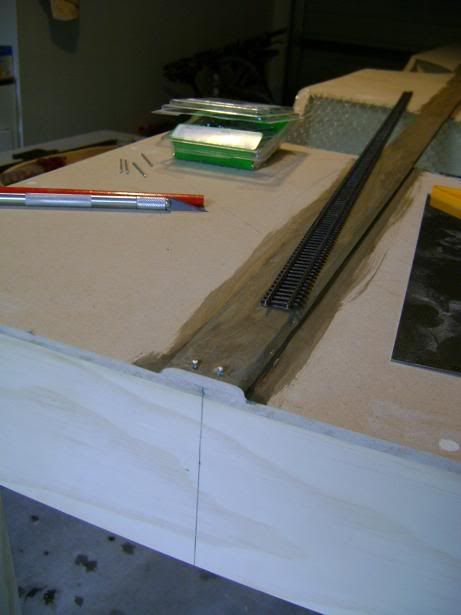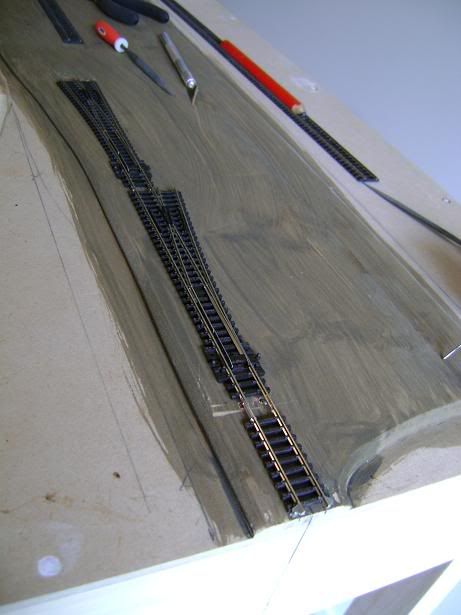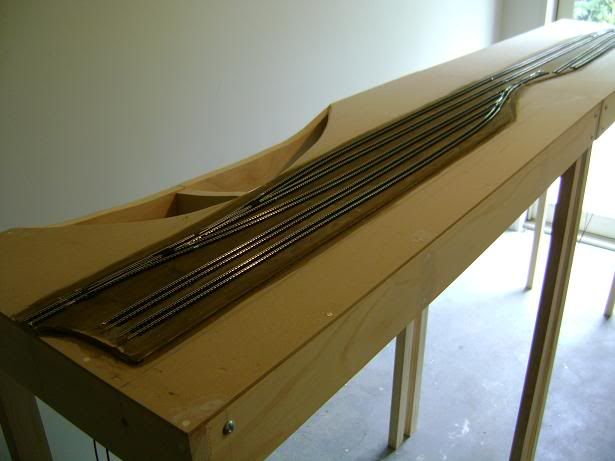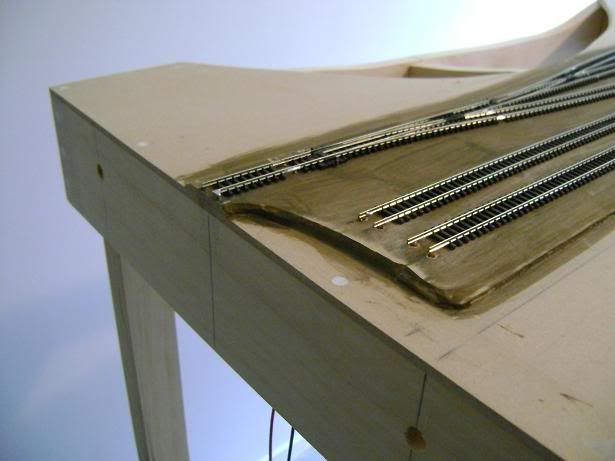
I decided to lay the track on the bridge module first to get a bit of practice before moving onto the more complex track arrangement on the yard sections.

Stage one of laying the track was attaching the track to the outer edge. Because it is inevitable that the sharp track ends will be accidentally snagged at some stage, it is necessary to fix them at the edges. I decided to drive nails in alongside the track, and then solder the rails to these. While this works satisfactorily, it doesn't give the cleanest look. In the future I will solder the rails to screws driven in directly under the rails.

The track on the river section amounted to one and a bit lengths of flex track, so the appropriate length of flex track was cut with the Dremel cutting tool. After soldering the track sections together at the joiner, I soldered feeder wires to the bottom of the track, and fed these through holes I had drilled in the basedboard. I then glued the track down with PVA, and soldered the other end to the nails. A few dabs of PVA is strong enough for gluing the track down at this stage, because once the track is ballasted, there is no way it's coming back up again! Finally, I filed down the track ends flush with the end of the modules.
Next, I moved onto the yard sections, again starting at the edge and moving inwards. As predicted, the yard section was much more complicated. For a start, fitting the points together in the desired arrangement meant trimming the sleepers in various places. Thinking ahead, I drilled holes beneath the points in the appropriate places so that point motors could be attached at a later date. Also, I removed a couple of sleepers form each end of the points to make attaching and soldering the rail joiners an easier job. Replacing these sleepers would be one of the last jobs of the track laying.

Attaching the various feeder wires also took time. To simplify matters, I added feeders to all of the sections of track so as to not rely on the contact of the point blades to feed the sections of track with electricity. I had always planned on running the modules with DCC, and thankfully this makes wiring a great deal more simple. Still, I expect I could have got away with fewer feeders, but I thought the extra time spent adding them would ultimately mean better running performance in the future. With this in mind I also decided to solder all the rail joiners, though this was a decision I was not entirely happy with later on, as I will explain in a future post.

After a great deal of cutting, trimming, soldering, hole-drilling, and filing (and some annoyed swearing), I finished laying the track. At this stage I had not glued it down, as I thought it was wise to thoroughly test the track for a period before fixing it permanently.

I was pretty satisfied with how things had gone, and glad to be finished. I'm in awe of those modelers who hand build track; for me laying commercial track is enough of an ordeal. Still, time and effort put in at this stage of the build is crucial to the running quality you eventually get.

Next time: starting on the scenery.
Looks like another top rate job, you should be proud.
ReplyDeleteI'm having to face the reality of hand laying all my track for my On30 layout. Just realised i'll need over a 1000 sleepers. Makes me jealous that your track was so easy!
What's the prototype for your On30 layout? It seems like a nice scale for detailed models in a reasonable space.
ReplyDeleteMy layout is entirely fictional, I've got a bit of a project log here:
ReplyDeletehttp://railroad-line.com/forum/topic.asp?TOPIC_ID=27022&whichpage=1
Had a bit of a false start but I'm right back into it now, albeit with a few modifications to the track plan and type of landscape. I'm now modelling the Glenorchy area near Queenstown, as if a narrow gauge line went up the Dart River valley.
I like the scale for the detail, although it does take up more space when using large locos. It's also nice to be able to model my own creations rather than follow any prototype.